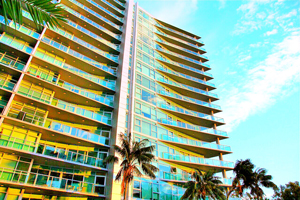
Residents at the Regatta Seaside condo tower in Marina del Rey could have almost a minute to duck and cover before the “The Big One” strikes.
That’s thanks to a new earthquake early warning system installed in the 19-story property at 13600 Marina Pointe Drive – the only residential building in the United States equipped with the technology, according to its developer, Santa Monica-based Early Warning Labs.
The early warning system is being rolled out to select customers by the company in partnership with the United States Geological Survey, a federal agency pioneering the early warning effort.
Regatta Seaside General Manager Robert Sides said the detection apparatus runs through the fire control system and would emit an audible alarm through each of the building’s 224 units in the event of an imminent earthquake registering an intensity of 6.0 or above.
“People can take shelter, get away from glass, get off their balcony, and get in a more sheltered area,” Sides said.
The system’s functionality is being expanded after being installed around three months ago. Early Warning is working with the Regatta to automate a number of responses in the wake of an earthquake warning to better protect residents and the building.
The system would trigger the building’s gates to open as a way to prevent first-responder vehicles from being trapped inside. It is also being programmed to trigger elevators in transit to drop off residents on the nearest floor so they don’t get trapped.
The warning could go off anywhere from zero to 90 seconds before the earthquake hits, depending on the magnitude and distance from the epicenter, according to Early Warning Chief Executive Josh Bashioum.
There are plans to make the technology more broadly available to business customers in the near future. Early Labs charges a monthly fee for the system, but Bashioum and Sides declined to disclose the amount.
Other early adopters include Universal Studios, the Los Angeles County Metropolitan Transportation Authority, and Santa Monica City College. Hospitals and other commercial buildings are in various stages of adoption, Bashioum said.
“We are fulfilling a commitment to the federal government to define use cases and support for the platform, technology,” he said. “Soon, we will release the product to market.”
A consumer version, he added, is still years away.
Properties installed with the technology can sell for a premium, said agent William Durfee of Gibson International, who has sold many Regatta units and previously served as the building’s sales manager.
“It usually depends on (buyers’) fear factor,” Durfee said. “Someone could pay up to 10 percent more just having that survival comfort. Some people are deathly afraid of earthquakes.”
The Regatta’s units range in price from $1 million to $2.3 million, he said.
The early warning system installed in commercial buildings works in conjunction with a network of 700 sensors along the West Coast that detect seismic activity.
Data from the sensors is processed by the network’s computers to identify whether an earthquake is about to take place and sent to Early Warning, which triggers the alarm.
While the system registers an earthquake’s intensity and how long it will take to hit, that information would not be communicated to Regatta residents in advance.
